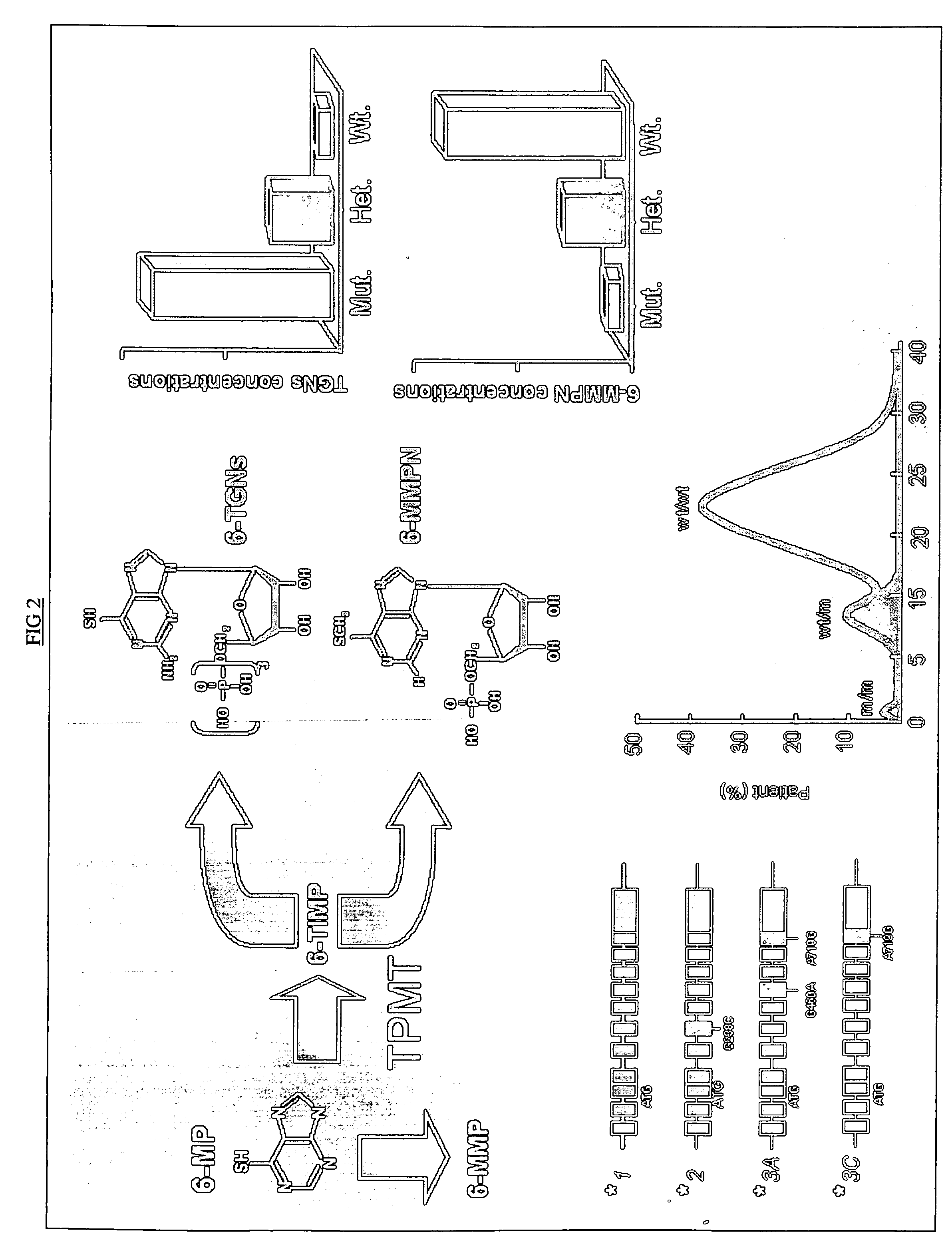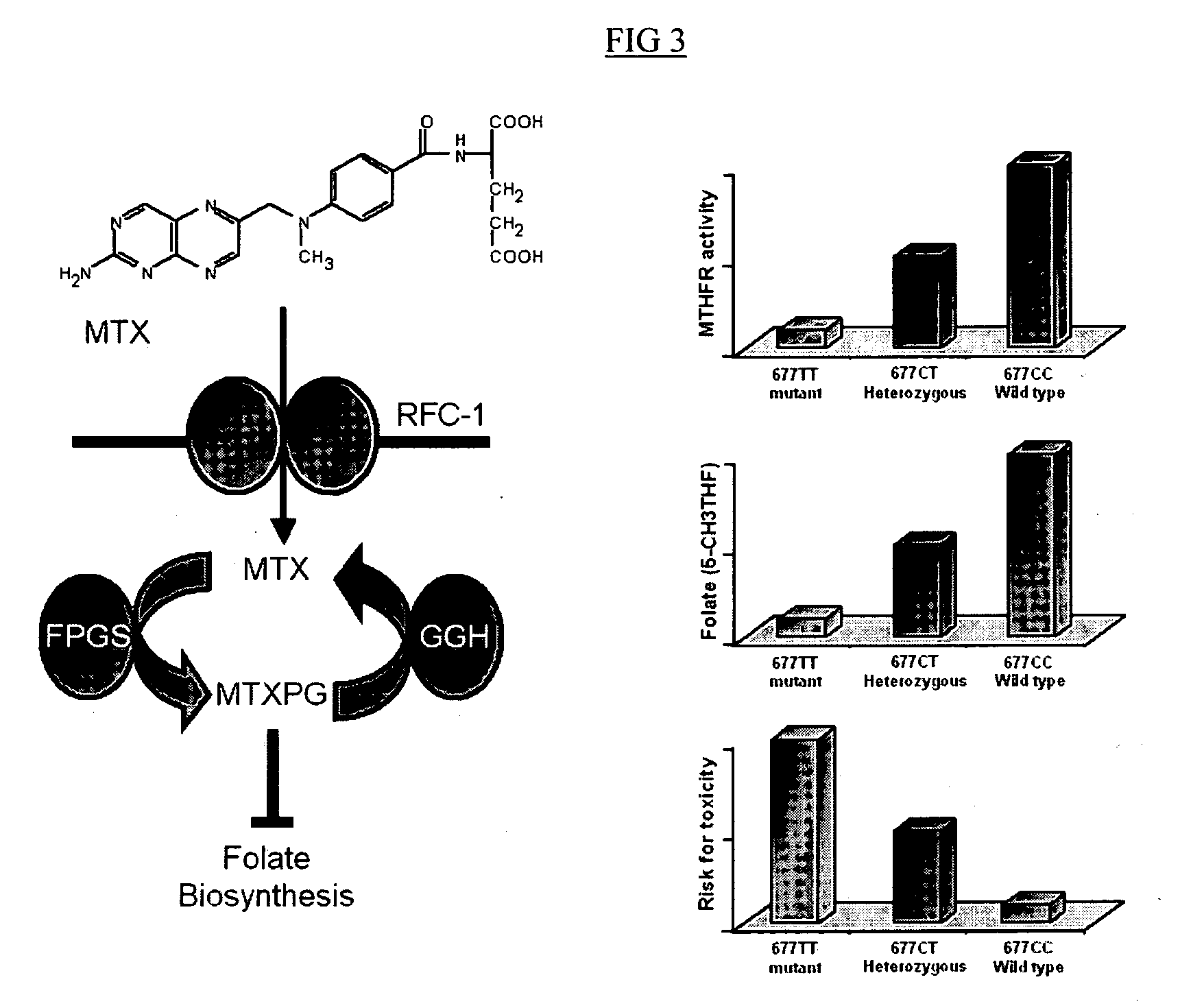Method to optimize drug selection, dosing and evaluation and to help predict therapeutic response and toxicity from immunosuppressant therapy
a technology of immunosuppression therapy and drug selection, which is applied in the direction of instruments, biochemistry apparatus and processes, proteomics, etc., can solve the problems of methotrexate treatment presenting a risk to the patient, not being commercially available, and first validating the target by pharmaceutical investigators, so as to reduce toxic side effects, effectively measure risk, and optimize the therapeutic effect of immunosuppression therapy
- Summary
- Abstract
- Description
- Claims
- Application Information
AI Technical Summary
Benefits of technology
Problems solved by technology
Method used
Image
Examples
example 1
[0111] Subject A with rheumatoid arthritis achieves therapeutic response to MTX at a MTXPG triglutmate level of 52 nmol / L. If Subject A's therapeutic drug metabolite level of MTX decreases by more than 13 nmol / L or increases by more than 17 nmol / L, then Subject A has attained a MCID in its metabolite level and indicates a clinical change in Subject A's therapeutic response, demanding a change in dose or discussion about compliance to therapy. Thus, Subject A has a therapeutic range of MTXPG (Glu-3) from 39 to 69 nmol / L, respectively.
example 2
[0112] Subject B with SLE maintains therapeutic response to CYC by using AZA at a 6-TG level of 187 pmol. If Subject B's therapeutic drug metabolite level of AZA decreases by 47 nmol or increases by more than 62 pmol, then Subject B has attained a MCID in its metabolite level and indicates a clinical change in Subject B's therapeutic response, demanding a change in dose or discussion about compliance to therapy. Thus, Subject B has a therapeutic range of 6-TG from 140 pmol to 249 pmol.
example 3
[0113] Subject C with psoriatic arthritis achieves therapeutic response to MTX at a MTXPG (Glu-3) level of 70 nmol / L. If Subject C is no longer responding to therapy in 12 months, then the therapeutic drug metabolite level can be measured to determine if a change in the subject's metabolite level has occurred. If Subject C's level has decreased by 17 nmol / L, then Subject B has achieved a MCID in the drug metabolite level suggesting that Subject C is no longer responding to therapy, due to drug resistance, non-compliance, or drug-drug interactions.
[0114] The drug metabolites include at least one of 6-dihydrofluorouracil (DHFU), 5′ deoxy-5′fluorocytidine (5′DFCR) and 5′deoxy-5′fluorouridine (5′DFUR) reported in mug / mL; 6-thioguanine and 6-methyl-mercaptopurine reported in ng / 8×10.8 RBC; 4-hydroxycyclophosphamide and carboxyethylphosphoramide mustard reported by ng ml(−1); anti-metabolite 2′,2′-difluorodeoxycytidine (dFdC) reported in microg / mL and 2′,2′-difluorodeoxyuridine (dFdU) re...
PUM
| Property | Measurement | Unit |
|---|---|---|
| molar ratio | aaaaa | aaaaa |
| time | aaaaa | aaaaa |
| concentrations | aaaaa | aaaaa |
Abstract
Description
Claims
Application Information
 Login to View More
Login to View More - R&D
- Intellectual Property
- Life Sciences
- Materials
- Tech Scout
- Unparalleled Data Quality
- Higher Quality Content
- 60% Fewer Hallucinations
Browse by: Latest US Patents, China's latest patents, Technical Efficacy Thesaurus, Application Domain, Technology Topic, Popular Technical Reports.
© 2025 PatSnap. All rights reserved.Legal|Privacy policy|Modern Slavery Act Transparency Statement|Sitemap|About US| Contact US: help@patsnap.com



